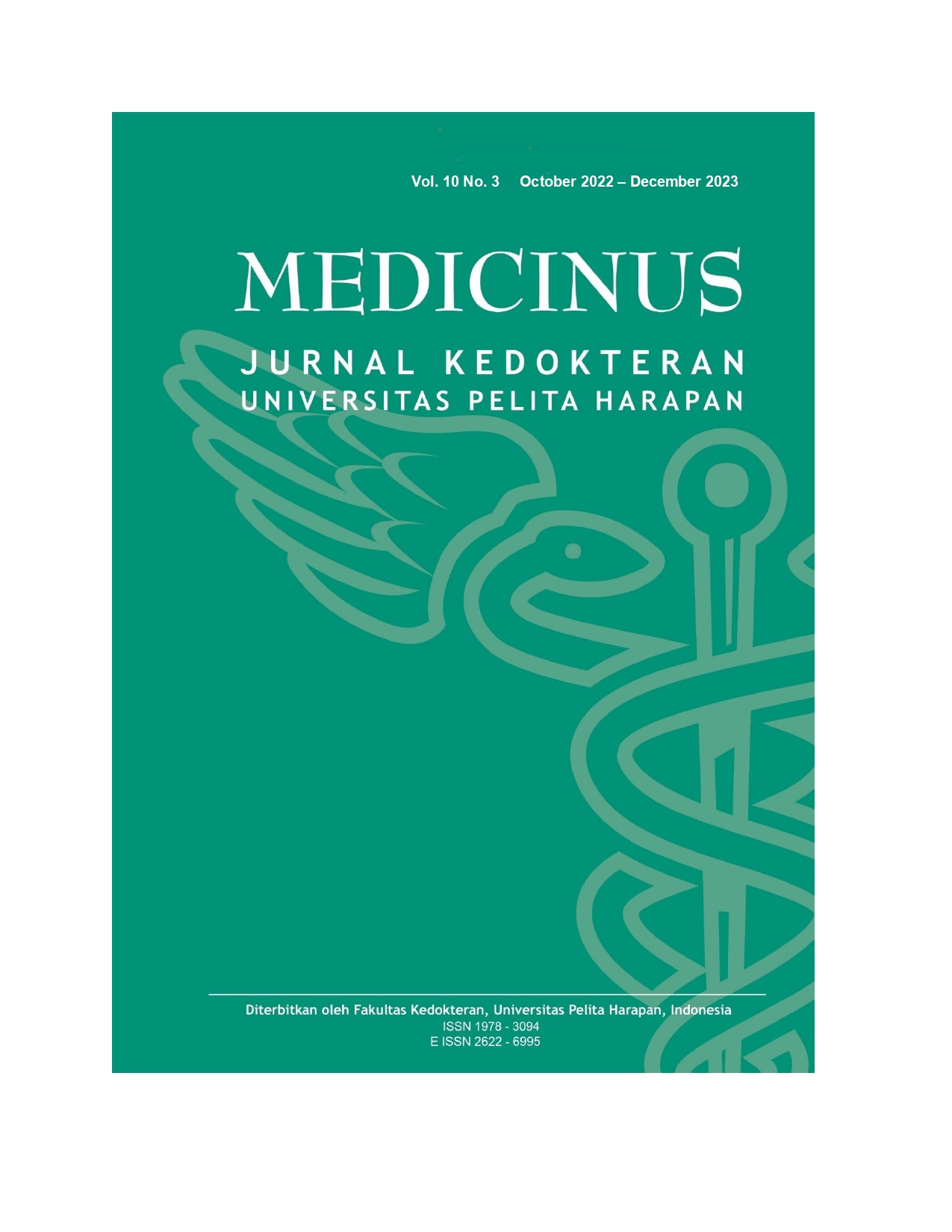The Difference of Low Density Lipoprotein Cholesterol Levels on Different Severity of Coronary Artery Disease Patients in Siloam Hospital Lippo Village
DOI:
https://doi.org/10.19166/med.v10i3.7033Keywords:
Coronary artery disease, Low-density lipoprotein, Number of vessel diseaseAbstract
Background: Coronary artery disease (CAD) is one of the highest causes of death in the world. Hypercholesterolemia, especially low-density lipoprotein (LDL) levels, is a major risk factor, because it is the main precursor of atherosclerosis. Previous studies showed the relationship between LDL level and the number of vessel disease is still inconsistent, therefore it needs to be observed further. The objective of this study was to know the effect of LDL levels on the number of vessel disease in CAD patients who underwent coronary angiography.
Methods: It was a cross-sectional and retrospective study, where data were taken from medical records of CAD patients who underwent coronary angiography at Siloam Hospital Lippo Village between January to June 2018. Patients with at least one vessel disease were included. The number of vessel disease was categorized into 3 groups: one-vessel, two-vessels, and multi-vessel. The relationship between LDL levels and the number of vessel disease was analyzed using one way ANOVA.
Result: The data includes 90 patients; 70 (77.8%) were male with average age of 56±9 years. There were 32 (35.6%) patients in one-vessel group; 27 (30%) in two-vessel group; and 31 (34.4%) in multi-vessel group with an average LDL levels of 106.43±40.51 mg/dl; 111.15±39.43 mg/dl; and 114.52±32.55 mg/dl respectively. Although it seemed that the increase in LDL cholesterol levels was in line with the number of vessel disease, there was no statistically significant relationship between the two variables (p=0.694).
Conclusions: LDL cholesterol level does not affect the number of vessel disease in CAD patients.
References
1. Cardiovascular diseases (CVDs) [Internet]. World Health Organization. 2018 [cited 17 August 2018]. Available from: http://www.who.int/news-room/fact-sheets/detail/cardiovascular-diseases-(cvds)
2. Kemenkes RI. Laporan Riset Kesehatan Dasar. Jakarta: Kemenkes RI; 2013
3. Kemenkes RI. Indonesia: Sample Registration System 2014. Jakarta: Kemenkes RI; 2014
4. Stone NJ, Robinson JG, Lichtenstein AH, Merz NB, Blum CB, Eckel RH, et al. 2013 ACC/AHA Guideline on the Treatment of Blood Cholesterol to Reduce Atherosclerotic Cardiovascular Risk in Adults: A Report of the American College of Cardiology/American Heart Association Task Force on Practice Guidelines. J Am Coll Cardiol. 2014;63(25PtB): 2889-934. https://doi.org/10.1016/j.jacc.2013.11.002
5. Perak AM, Ning H, de Ferranti SD, Gooding HC, Wilkins JT, Lloyd-Jones DM. Long-term risk of atherosclerotic cardiovascular disease in US adults with the familial hypercholesterolemia phenotype Clinical perspective. Circulation. 2016;134(1):9-19. https://doi.org/10.1161/circulationaha.116.022335
6. Ference B, Ginsberg H, Graham I, Ray K, Packard C, Bruckert E et al. Low-density lipoproteins cause atherosclerotic cardiovascular disease. 1. Evidence from genetic, epidemiologic, and clinical studies: A consensus statement from the European Atherosclerosis Society Consensus Panel. Eur Heart J. 2017;38(32):2459-2472. https://doi.org/10.1093%2Feurheartj%2Fehx144
7. Risk Factors [Internet]. World Health Organization. 2018 [cited 17 August 2018]. Available from: http://www.who.int/cardiovascular_diseases/en/cvd_atlas_03_risk_factors.pdf?ua=1
8. Rafieian-Kopaei M, Setorki M, Doudi M, Baradaran A, Nasri H. Atherosclerosis: Process, Indicators, Risk Factors and New Hopes. Int J Prev Med. 2014;5(8):927-946. http://www.ncbi.nlm.nih.gov/pmc/articles/pmc4258672/
9. Levine G, Bates E, Blankenship J, Bailey S, Bittl J, Cercek B et al. 2011 ACCF/AHA/SCAI Guideline for Percutaneous Coronary Intervention: A Report of the American College of Cardiology Foundation/American Heart Association Task Force on Practice Guidelines and the Society for Cardiovascular Angiography and Interventions. Circulation. 2011;124(23):e574-e651. https://doi.org/10.1161/cir.0b013e31823ba622
10. Saito R, Kawai Y, Watanabe M, Motoyama A, Ishida R, Kitayama M et al. 362 Atherogenic Lipid Profile and Development of Multivessel Coronary Artery Disease in Women. Atherosclerosis Supp. 2011;12(1):78. http://dx.doi.org/10.1016/S1567-5688(11)70363-4
11. Chieng D, Pang J, Ellis K, Hillis G, Watts G, Schultz C. Elevated lipoprotein(a) and low-density lipoprotein cholesterol as predictors of the severity and complexity of angiographic lesions in patients with premature coronary artery disease. J Clin Lipidol. 2018;12(4):1019-1026. https://doi.org/10.1016/j.jacl.2018.03.090
12. Penalva RA, Huoya Mde O, Correia LC, Feitosa GS, Ladeia AM. Lipid profile and intensity of atherosclerosis disease in acute coronary syndrome. Arq Bras Cardiol. 2008;90(1):24-30. https://doi.org/10.1590/s0066-782x2008000100005
13. Khashayar P, Mohagheghi A. The correlation between dyslipidemia and coronary artery disease based on angiographic findings in an Iranian population. Acta Med Indones. 2010;42(2):82-5.
14. Rojas F, De Frutos T, Ponte A, Chacón J, Vitale G. Coronary Heart Disease and Dyslipidemia: A Cross-Sectional Evaluation of Prevalence, Current Treatment, and Clinical Control in a Large Cohort of Spanish High-Risk Patients: The PRINCEPS Study. Prev Cardiol. 2009;12(2):65-71. https://doi.org/10.1111/j.1751-7141.2008.00022.x
15. Wasilewski J, Niedziela J, Osadnik T, Duszańska A, Sraga W, Desperak P et al. Predominant location of coronary artery atherosclerosis in the left anterior descending artery. The impact of septal perforators and the myocardial bridging effect. Kardiochir Torakochirurgia Pol. 2015;4:379- 385. https://doi.org/10.5114/kitp.2015.56795
16. Wasilewski J, Niedziela J, Osadnik T, Roleder M, Nowakowski A, Glowacki J et al. The Role of Septal Perforators and “Myocardial Bridging Effect” in Atherosclerotic Plaque Distribution in the Coronary Artery Disease. Pol J Radiol. 2015;80:195-201. https://doi.org/10.12659%2FPJR.893227
17. Gruzdeva O, Uchasova E, Dyleva Y, Belik E, Karetnikova V, Shilov A et al. Multivessel coronary artery disease, free fatty acids, oxidized LDL and its antibody in myocardial infarction. Lipids Health Dis. 2014;13(1):111. https://doi.org/10.1186%2F1476-511X-13-111
Downloads
Published
How to Cite
Issue
Section
License
Copyright (c) 2023 Michael Tanaka, Wilbert Santoso, Novita Anggraini

This work is licensed under a Creative Commons Attribution-ShareAlike 4.0 International License.
Authors who publish with this journal agree to the following terms:
1) Authors retain copyright and grant the journal right of first publication with the work simultaneously licensed under a Creative Commons Attribution License (CC-BY-SA 4.0) that allows others to share the work with an acknowledgement of the work's authorship and initial publication in this journal.
2) Authors are able to enter into separate, additional contractual arrangements for the non-exclusive distribution of the journal's published version of the work (e.g., post it to an institutional repository or publish it in a book), with an acknowledgement of its initial publication in this journal.
3) Authors are permitted and encouraged to post their work online (e.g., in institutional repositories or on their website). The final published PDF should be used and bibliographic details that credit the publication in this journal should be included.





